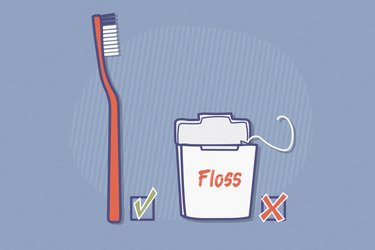
Just like updating your resume, exercising daily and social distancing during a pandemic, flossing is one of those things you know is good for you — even if you don't particularly enjoy doing it.
Turns out, many of us aren't so into the oral activity. An August 2018 study in Periodontology found that only 32 percent of Americans floss every day, while another 32 percent never floss.
Video of the Day
Video of the Day
So if you're not exactly religious about cleaning between your chompers, you're not alone. But do you really need to floss? We tapped dental experts for the answer.
What’s the Point of Flossing, Anyway?
"Put simply, flossing cleans between the teeth where brushing can't reach," says Tim Iafolla, DMD, chief of program analysis and reporting for the National Institute of Dental and Craniofacial Research (NIDCR). "The goal is to disrupt the formation of dental plaque — a sticky coating composed of bacteria and food particles on the surfaces of your teeth."
Sally Cram, DDS, a Washington, D.C.-based periodontist and spokesperson for the American Dental Association, likens the gums surrounding each tooth to a turtleneck.
"Your job is to remove the plaque that accumulates under the 'turtleneck collar' of gum tissue," she says. "Brushing clears it from the outside and inside of your teeth, but it doesn't completely reach in between the teeth where they touch."
All sorts of symptoms can start to creep in if you fail to clear out the plaque. Let's take a look:
Bloody Gums and Bad Breath
Lingering plaque can cause gingivitis, an inflammation of the gums.
"The onset of gingivitis can take as little as 24 hours," Dr. Iafolla says, which is why flossing once a day is recommended.
Early signs of gingivitis include swollen, tender gums that bleed when you brush or floss and persistent foul-smelling breath.
The good news?
"Gingivitis is reversible by having more frequent professional cleanings and by doing a better job with home care, brushing and flossing your teeth," Dr. Cram says. "The gums will become tight and pink again, with no bleeding."
Related Reading
Loose Teeth
It's critical to nip gingivitis in the bud before it progresses to a more serious condition: periodontitis.
"When plaque isn't removed promptly, it absorbs calcium from saliva and soon hardens into calculus, which can only be cleared away with professional dental cleaning instruments," Dr. Iafolla says. "If calculus stays in place for a long period of time, it can result in periodontitis, an inflammatory condition that can cause the gums to pull away from the teeth and for supporting bone to be lost. Eventually, severe periodontitis leads to loosening of teeth and tooth loss."
A single night or two of skipping the floss won't cause your teeth to fall out, so you can breathe easy here. Periodontitis occurs gradually, due to poor oral hygiene over time.
"Periodontitis can take months or years to develop, although this is very variable from patient to patient," Dr. Iafolla says. "Gingivitis and periodontitis are the body's inflammatory reaction to plaque and calculus, and some people are more prone to inflammation than others."
Smoking, diabetes, female hormonal changes, stress, heredity, crooked teeth and certain medications can increase your risk of gum disease, according to the Centers for Disease Control and Prevention.
Related Reading
Cavities and Decay
Our mouths have thriving microbiomes, typically made up of high levels of good bacteria and low levels of bad bacteria.
"That balance of good and bad microorganisms reverses when you have periodontal disease," Dr. Cram says. "The amount of harmful bacteria that causes inflammation and infection rises."
That yucky bacteria can also rot your pearly whites.
"It ferments the sugar in your diet and creates acid, which eats holes in the teeth," Dr. Cram says.
"Oral hygiene is not just about saving your teeth, but also preserving your general health."
Serious Health Issues
The condition of your mouth isn't the only thing at risk when bad bacteria builds up.
"Inflammation caused by bacterial deposits and periodontal disease enters the bloodstream, where it can travel to other parts of the body, leading to systemic issues including heart disease and possibly diabetes, and putting you at greater risk of heart attack and stroke," Dr. Cram says, noting that there have even been cases where untreated tooth infections cause an abscess in the brain.
"Oral hygiene is not just about saving your teeth, but also preserving your general health."
Related Reading
The Great Flossing Controversy
Now for an interesting twist: Although proper oral hygiene is a no-brainer and dental professionals are all for interdental cleaning, science suggests that the jury is still out about whether or not flossing itself is required.
A January 2015 review in Clinical Periodontology found "inconsistent/weak evidence" for flossing as a means of preventing gingivitis "due to a lack of efficacy." Three months later, a second review in the same journal reported "weak evidence of unclear or small magnitude" to support flossing's role in reducing plaque and gingivitis.
Dr. Iafolla's response?
"Study results vary, and more research is needed on this issue, particularly with regard to whether flossing does or does not have an impact on the progression of gum disease and tooth decay," he says. "That said, flossing is a low-risk, low-cost way to clean parts of your teeth where your toothbrush can't reach."
We can't argue with that logic.
Solutions for Floss-Haters
More than one-third of Americans would rather clean the toilet than floss on a daily basis, according to a June 2015 survey by the American Academy of Periodontology.
If you're among these folks: "First, check your flossing technique," Dr. Iafolla says. "Your dentist or dental hygienist will be happy to show you some flossing tips and tricks that might make it easier."
There are also effective plaque-busting alternatives, such as a water flosser, floss holder, rubber tip or interdental brush. "The important thing is to disrupt the plaque before it hardens into calculus," Dr. Iafolla says.
Try These Products
- BURST Water Flosser Kit ($69.99, BURST Oral Care)
- Flossaid Dental Floss Holder ($7.73 for 3-pack, Amazon)
- DenTek Easy Brush Cleaners ($3.86 for 16-count, Walmart)
5 Common Flossing Mistakes (and Easy Fixes)

If weaving string between your chiclets is painful or tricky, it might be a sign you're doing it wrong. Follow these strategies from Dr. Iafolla and Dr. Cram, and check out the ADA's illustrated step-by-step guide to flossing.
1. You're Flossing in Front of a Mirror
"It's difficult to coordinate your hands and eyes when the image is reversed; some people find it easier to navigate by feel rather than by sight," Dr. Iafolla says. "It takes practice but soon becomes second nature for most people, especially if you stick to the same flossing pattern (upper jaw to lower jaw, left to right, etc.) and don't skip around."
2. You Pinch the Floss Between Your Fingertips
This position can cause the floss to slip out of your grasp.
"Wrapping the floss around your fingers makes it easier to handle," Dr. Cram says. "If you're having trouble manipulating it due to arthritis or a lack of dexterity, talk to your dentist."
3. You’re Using Too Little Floss
"The floss should be at least 18 inches long, with the unused floss wrapped around the middle and ring fingers of both hands," Dr. Iafolla says. A longer piece is "easier to navigate and control than a short piece."
4. You Cut Your Gums
"This can cause pain and damage the delicate interdental tissue," Dr. Iafolla says. "It's better to use a gentle sawing motion to slide the floss through" rather than snapping the floss down between your teeth.
If you have very tight teeth, use a floss threader to maneuver it between your chompers.
5. You Ignore the Sides of Your Teeth
"At the gum line, curve the floss into a C-shape against your tooth and move it up and down, gently rubbing the side of each tooth," Dr. Cram says.
So, How Bad Is It Really to Never Floss?
Hey, if flossing isn't your thing, it's not a deal-breaker.
"The goal is to remove plaque between the teeth every day, whether it's with floss or some other interdental method," Dr. Iafolla says. But if you never clean between your teeth, period, you're playing with fire.
"Nobody is perfect, and just like dieting or exercising, skipping a day here and there probably won't hurt — in fact, some lucky people have healthy mouths despite never flossing," Dr. Iafolla says. "But a dentist can almost always tell when somebody doesn't floss [on a regular basis]. There are usually clear signs when the interdental areas are being neglected — sometimes it's plaque or calculus buildup, and sometimes it's a more serious condition like gingivitis or periodontitis."
Let's be real: The time it takes to floss your teeth is the equivalent of watching two TikTok videos. You can do this!
Related Reading
- Journal of Clinical Periodontology: "Efficacy of inter-dental mechanical plaque control in managing gingivitis--a meta-review"
- NICDR: "Periodontal (Gum) Disease"
- Centers for Disease Control and Prevention: "Periodontal Disease"
- Journal of Clinical Periodontology: "Primary prevention ofperiodontitis: managing gingivitis"
- AAP: "MORE THAN A QUARTER OF U.S. ADULTS ARE DISHONEST WITH DENTISTS ABOUT HOW OFTEN THEY FLOSS THEIR TEETH"
- ADA MouthHealthy: "5 Steps to a Flawless Floss"
- Journal of Periodontology: "Prevalence of daily flossing among adults by selected risk factors for periodontal disease— United States, 2009-2014"
Is this an emergency? If you are experiencing serious medical symptoms, please see the National Library of Medicine’s list of signs you need emergency medical attention or call 911.
